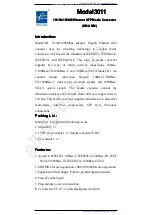3. Connector Pin Assignments
Table
2
–
Pin
Header
1
(JP1)
Pin
Designator
Notes
JP1
PTT
Input
or
Relay
Out
See
note
#1
JP2
Ground
JP3
Jumper
Usually
used
to
switch
configurations
JP4
IRQ
See
Note
#2
JP5
ADC0
On
‐
board
temperature
sensor
JP6
ADC1
On
‐
board
divider
provides
1/3
V
in
JP7
ADC2
Extra
ADC
input
or
1
‐
wire
data
bus
JP8
V
in
6.7
to
35
VDC
JP9
V
ext
(see
Note
#3)
JP10
+5
Volts
DC
Output
of
regulator
U2
Note
#1
–
JP1
can
be
used
for
either
PTT
input
for
mic
encoder
operation,
or
as
a
relay
control
output
if
power
control
is
enabled.
When
used
as
a
relay
output,
the
pin
can
provide
no
more
than
15
ma
current.
Note
#2
–
JP4
pulled
momentarily
to
ground
will
force
an
immediate
transmit.
Note
#3
–
If
JP8
and
JP9
are
jumpered
together,
pin
4
on
connecter
X2
(Serial
Port)
can
be
used
to
supply
raw
voltage
(Vin)
to
an
external
device
such
as
a
GPS
receiver,
or
to
receive
power
via
a
specially
wired
cable
assembly.
JP9
and
JP10
may
be
connected
to
provide
regulated
5
volt
power
on
pin
4.
Table
3
–
DB9
Female
(X1)
–
Radio
Port
Table
4
–
DB9
Male
(X2)
–
Serial
Port
Pin
Function
1
No
Connection
2
Data
In
3
Data
Out
4
V
ext
5
Ground
6
No
Connection
7
No
Connection
8
No
Connection
9
No
Connection
Pin
Function
1
Audio
Out
2
COR
/
Squelch
Input
3
PTT
4
No
Connection
5
Audio
In
6
Ground
7
Power
in
8
PTT
Input
9
No
Connection
X2
is
wired
as
DTE
to
allow
connection
to
a
GPS
receiver
using
a
standard
cable.
A
null
modem
cable
is
required
for
connection
to
a
computer.
By
default,
the
OpenTracker
expects
GPS
data
to
be
in
NMEA
‐
0183
format
at
4800
baud.
OpenTracker Manual - Version 1.05 – 6/25/06
page of
23
6

















